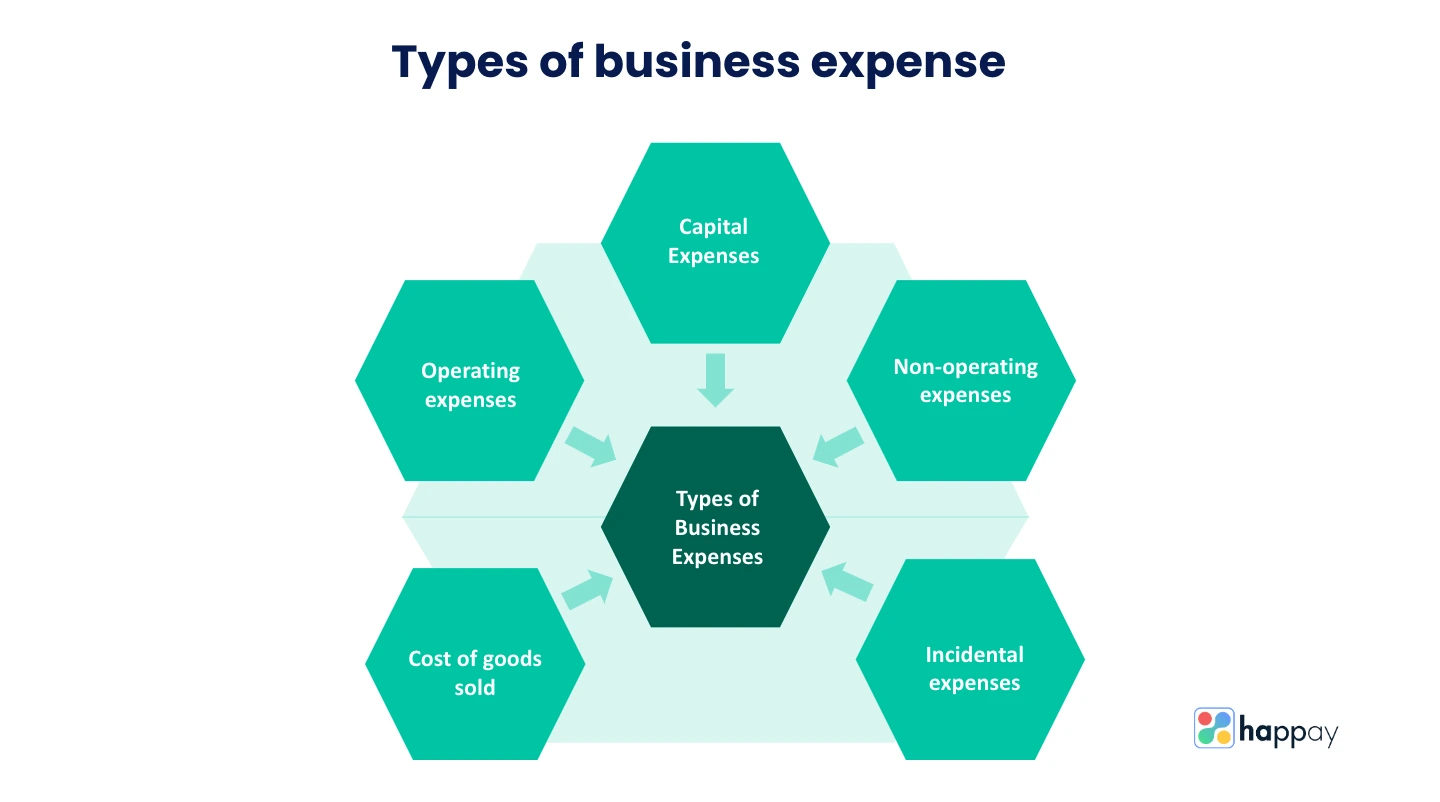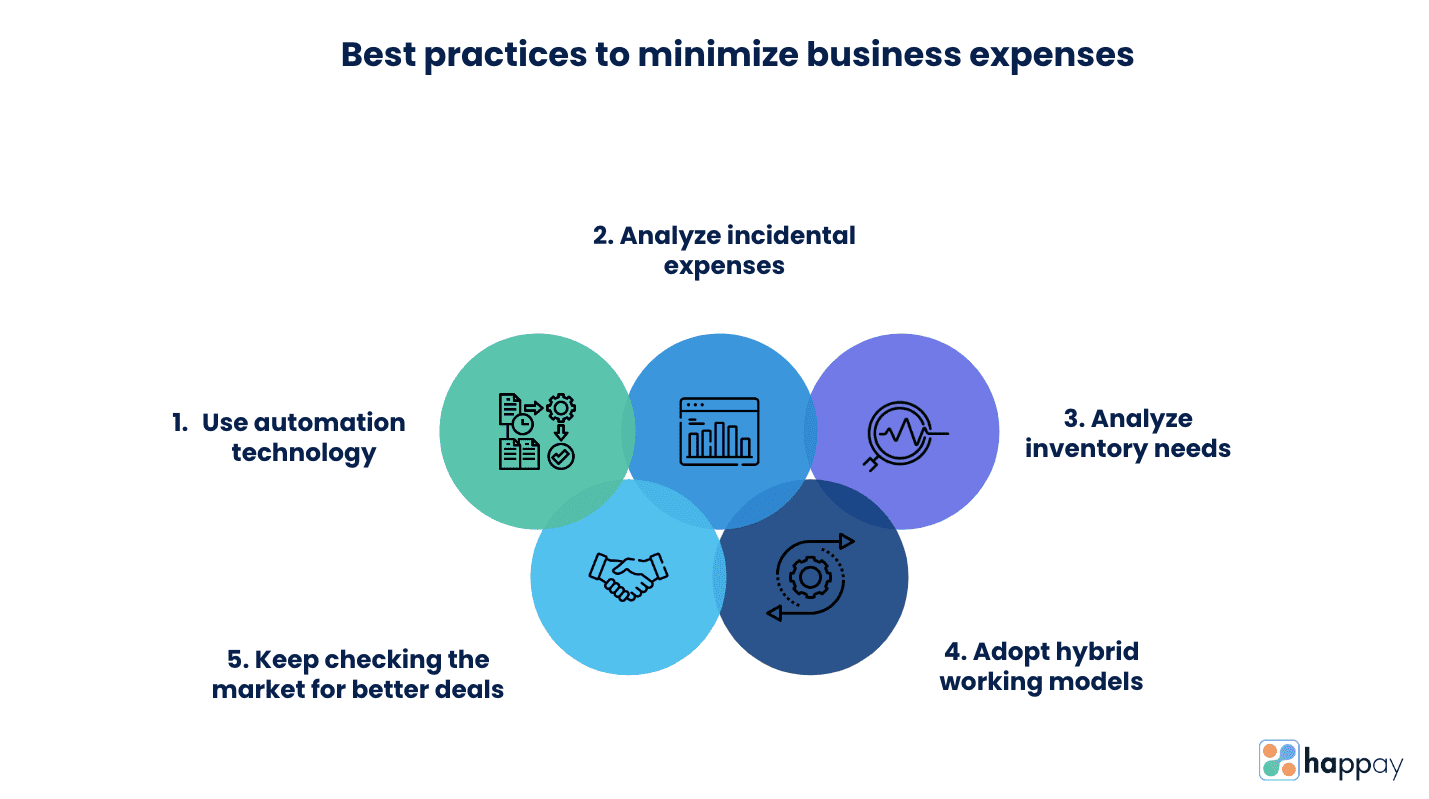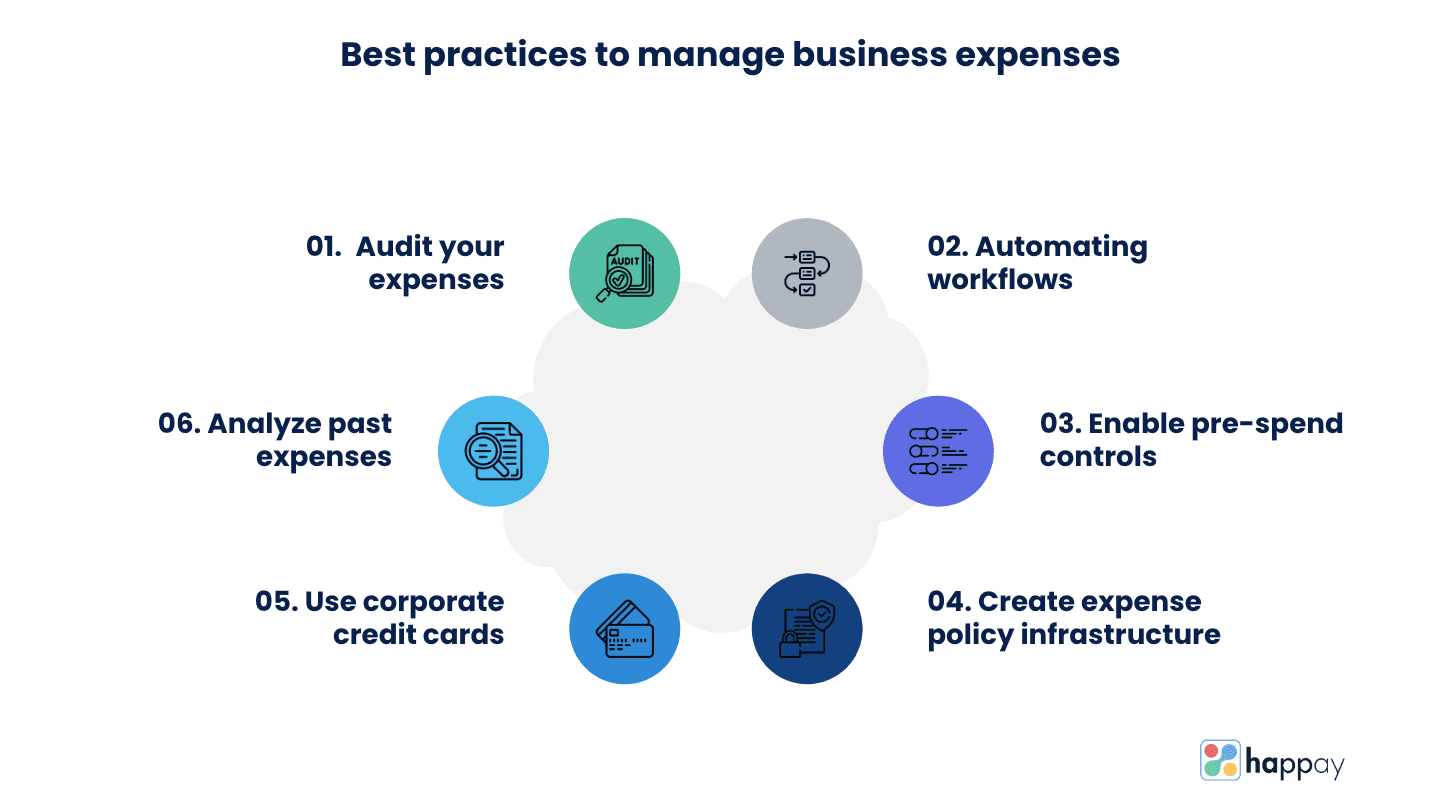Last Updated on November 27, 2025
Introduction
“Money often costs too much.” – Ralph Waldo Emerson
It takes money to make money. Companies exist primarily to make money, but in due process, they incur various business expenses crucial to their existence. Running a business requires a dedicated workforce, strong leadership, business acumen, and, most importantly, a constant influx of funds.
What are business expenses?
All expenses incurred for business purposes by an organization are business expenses. They are optional, regular, and incidental costs that fund a company’s survival, growth, and everyday functioning. Every spending that helps sustain the business can be classified as a business expense, from fixed expenses like plant and machinery to trivial expenses like client gifts.
Suggested Read: What are Business Travel Expenses?
Types of business expenses based on the frequency
All money spent for business use is a business expense. Classification of these expenses is essential to important finance functions like accounting, budgeting, cash flow forecasting, and expense management. Based on the frequency and occurrence, you can classify business expenses as follows.
1. Fixed expenses
These costs are recurring and do not change every month. They are predictable expenses. While they can change or increase with time, they remain the same during a specific predetermined period. Examples are base salaries, office rent, mortgages, etc.
2. Variable expenses
These expenses differ monthly, and their value depends on certain factors. For example, the sales commission given to the sales personnel is a variable expense. It depends on the number of sales made by the team.
The higher the sales figure, the higher the expense would be. Other variable expenses are electricity, inventory and storage, shipping, and credit card fees.
3. Recurring expenses
These expenses repeat throughout the month. They are not predictable and rarely depend on other factors to be incurred. Some regular expenses are staff compensation, administrative costs, subscriptions, memberships, communication costs, etc.
4. Non-recurring expenses
These expenses are incurred once or twice a year. Examples of non-recurring costs include mergers and acquisitions, lawsuit settlement fees, purchase of new equipment or real estate, etc.
Suggested reading: Beyond Budgets: A Guide to Project Expense Management
Types of business expenses based on function

1. Operating expenses
Operating expenses are used to pay for the day-to-day functioning of a business. All direct business-related costs facilitating the production and manufacturing of goods can be categorized as operating expenses. Administrative, compensation, sales, and marketing-related costs are all operating expenses.
2. Non-operating expenses
Non-operating expenses fund additional functions required to sustain a business’s financial health and operations. They include one-time expenses like lawsuit settlements, inventory write-offs, and regular expenses like interest payments and depreciation. These costs are not used to facilitate the core business operations, nor do they pay for the production of goods.
3. Capital expenses
Capital expenses are used to fund the business’s purchase, management, modification, or maintenance of capital assets. Examples of capital expenditures are money spent on building buildings, upgradation of machinery, digital infrastructure, company vehicles, etc.
4. Cost of goods sold or COGS
The cost of goods sold, or COGS, is the summation of all the expenses that directly fund the conception and manufacturing of the final business offerings. They include the cost of raw materials, salaries of employees directly involved in producing goods, machinery, factory, packing, etc.
5. Incidental expenses
Incidental expenses are unplanned and primarily unpredictable. They are mainly trivial expenses such as auxiliary costs during travel, like room service, baggage handling fees, entertainment expenses, staff tips, etc.
Quick read: Discretionary Expenses: Definition, Types, and Budgeting
List of common business expenses
- Rent – Renting the place of business, factories, manufacturing units, or any property that facilitates the company’s operations.
- Machinery – You need machine equipment to produce the business offerings.
- Compensation – The salary or compensation of all permanent or temporary employees.
- Travel expenses – All costs related to business travel, including flight fares, accommodation fees, transportation, business mileage, etc.
- Utilities – Services that facilitate the everyday functioning of a workplace are called utilities. They include electricity, water, internet, sewage, etc.
- Interest expenses – Bank fees, including all the monthly interest paid on loans.
- Maintenance and repairs – Machines and equipment suffer wear and tear over time. Maintenance and repair funds facilitate their restoration.
- Advertising – The cost of promoting the business’s goods and services and attracting customers.
- Patents – The money spent to safeguard the company’s intellectual property and trade secrets of the company.
- Technology – All the hardware and software you use in the company, like computers, laptops, projectors, management software, accounting software, etc.
- Legal fees – The cost of availing legal services.
- Taxes – All taxes you pay in a tax year, including income tax, commercial property tax, etc.
a) Which business expenses are tax deductible?
You can lower your tax liability on your taxable income by claiming returns on certain expenses. Here is a list of allowable deductible business expenses. This list is not exhaustive.
- Rent and other office expenses
- Payroll
- Employee benefits like health insurance, maternity leaves, retirement plans, employee education expenses, etc.
- Repairs and maintenance
- Insurance premium
- Mortgage interest
- Depreciation on machinery, building, manufacturing plants, etc.
- Depreciation on patents and copyrights
- Expenditure on scientific research
- Home office expenses
b) Which business expenses are non-tax deductible?
Here are a few business expenses that you cannot claim returns on.
- Interest, fees, and royalties for any technical services outside the country.
- Salary paid outside India
- Interest, commission or brokerage, fees for professional services, or fees for technical services paid to employees without TDS and its payment
- Tax on non-monetary requisites paid by the business on behalf of employees
- Wealth tax
- Income tax
This list is not exhaustive. Refer to this government’s official website to know about all the tax disallowances.
Suggested Read: SG&A: Selling, General and Administrative Expenses
What type of business expenses need to be tracked?
You need to track all kinds of business expenses, including capital, operating, non-operating and incidental expenses. Operating expenses are recurring and periodic, so tracking them can alert you to irregularities. Keeping a close eye on them is important as they account for a major part of your spending.
On the other hand, incidental expenses are minor yet considerable. Incidental expenses are hard to keep track of. In-office incidental expenses are paid for using petty cash funds. It is crucial to devise a system that can track petty cash expenditures. Otherwise, it becomes susceptible to siphoning by employees who keep it for personal use.
How to track and calculate business expenses?
1. Tracking business expenses
Business expenses can be tracked using the following methods.
a) Manual method and spreadsheets
The traditional method of tracking business expenses is manually analyzing expense reports, purchases, invoices, and receipts and recording them on a spreadsheet. This method is outdated and vulnerable to expense fraud, data loss, and data contamination.
b) Using an automated expense management software or accounting system
An expense management software is more efficient than the manual method. Expense reporting tools can directly consolidate expense data through automatic receipt capture and extracting data from multiple data points.
c) Using corporate or business credit cards
Corporate credit cards or business credit cards automatically record every transaction made through them. This means that you only need to consolidate and categorize the spend data for analyses and don’t have to rely on receipts or expense reports.
2. Calculating business expenses
Calculating the total company expense is easy if you efficiently track your business expenses. But before we see how we can calculate business expenses, let’s learn the meaning of two key terms.
- Revenue – The total amount of money you get after selling your goods and services for a specific period.
- Net income – It is the total amount of money you save after paying for all the expenses. The balance sheet represents the net business income as the difference between the starting and ending equity.
To calculate business expenses, use this formula.
Total expenses = Total revenue – net income
Benefits of tracking business expenses

No matter if you are a large business, small business, or startup, tracking business expenses can effectively lead to reduced costs and more savings. Here are a few of the best benefits of tracking business expenses.
1. Easier audits
Businesses perform expense audits to ensure policy compliance and for tax purposes. Tracking expenses allows you to record and maintain an accurate history of all business transactions. If you use expense tracking software to record expenses, you will have digital records of all your purchases. Hence, accessing data and searching for specific data points will be easier during audits.
2. Business tax deductions
Filing income tax returns is a tedious process. Identifying all the expenses that qualify for deductions can be difficult if you don’t track expenses regularly. Efficient expense tracking allows you to identify all tax deductibles and file them timely.
3. Fewer expense frauds
Expenses frauds occur when employees use company funds to cover personal expenses. Expense tracking allows for prompt scrutiny and examination. Automated expense tracking also helps avoid overstated expense filings and duplicate receipts. It also gives the employees a degree of accountability and deters them from committing expense fraud.
4. Fewer cost leakages
Tracking expenses regularly allows you to analyze, compare, and recognize patterns in spend data. These patterns help you identify areas that cause cost leakages and wasted resources. You can use this information to optimize certain processes and increase cost efficiency.
5. Savings and better deals
Analyzing past expenses can help you identify frequent vendors, service providers, and merchants. You can leverage this data to negotiate better deals on future purchases.
How to analyze business expenses?
1. List down all revenue accounts
Review your business bank account and your company’s income statement and financial statement. Create a list of sales from all your products, services, and verticals for a specific time period. Revenue includes money earned by selling the business’ main offering and not through other business asset sales.
2. Calculate the cost of goods sold
Add all the expenses incurred while producing the goods or rendering services. These will be the costs of goods sold (COGS), including expenses like raw materials, machinery, labor costs, etc.
3. Calculate the gross margin
Deduct the COGS amount from the total revenue you calculated in step 1. This is the gross margin. You can use it to analyze the profitability level of your company. The higher the gross margin, the higher the profitability.
4. Study the changes in the gross margin
Compare the gross margin across time periods. You must identify its source if there is a significant change in it. Some reasons for gross margin change can be a change in product price, a decrease in COGS, or increased productivity.
5. Add and compare marketing costs
Identify all the marketing-related costs, including advertising, promotions, SEO, marketing-personnel salaries, website upload, and support, content cost, graphic designing costs, etc.
Compare these costs with other time periods. If there is a significant change in the profit margin and the advertising costs, it may indicate that your profits have increased because of your investment in marketing.
6. Administrative costs
Calculate the operating and administrative expenses, including salaries, utilities, rent, benefits, insurance, etc. Compute them as a percentage of sales. Compare the costs with past months. If there is an increase in operating expenses but no increase in margins, it may indicate cost leakages.
7. Analyzing gross profit
Deduct the cost of goods sold, operating expenses, non-operating expenses, etc., from your net sales revenue to get gross profit. Measure the gross profit as a percentage of the revenue generated through sales. This percentage can show you if your company is growing or not.
Suggested Read: Expense vs Expenditure
How can you minimize business expenses?
Cutting costs is one of the most challenging things to do. With inflation and expanding industries, expenses tend to increase rather than stabilize. However, there are certain measures you can stay to minimize these expenses.

1. Leverage automation technology
You can use automation technology to empower almost any department in your business. Consider automating the departments’ processes that handle bulk data and generate the most revenue. You can also use automation on an organization-wide managerial level to streamline communication, centralize data storage processes, and simplify record keeping.
Automation increases productivity and, in turn, increases output. This leads to higher profit margins and decreased expenses.
2. Analyze and modify current incidental expenses
Operating expenses are mostly recurring. If cost-cutting is a priority, you can let go of expenses like expensive client gifts, birthday parties, frequent offsites, etc. and focus on only essential expenses.
3. Analyze inventory needs and spend wisely
It is common for organizations to buy inventory in bulk to get deals that are better in the short term. This is not always a good idea, as unused inventory often gets wasted, damaged, or depreciates in value.
4. Adopt hybrid working models
Hybrid working models allow employees to work remotely for certain days a week. Hybrid models can help you save money on utility bills like electricity, water, internet, etc. It can also help save transportation costs if you fund employee commutes.
5. Keep checking the market for better deals
It is easy to overlook fixed expenses while minimizing costs, even though modifying them is one most sustainable methods to curtail spending. Keep checking the market for better deals on subscriptions and services. Getting more cost-effective fixed expenses will help you save money every month.
What is business expense management?
Business expense management is the practice of tracking, recording, and analyzing expenses to retrieve actionable information, initiate reimbursements, avoid frauds, enable audits and facilitate efficient budgeting.
What are the benefits of business expense management software?
The business world is volatile, and companies are always vulnerable to unprecedented issues. This is why businesses need to have sufficient funds to be able to survive unforeseen losses. Business expense management software can help with that. Let’s discuss the most significant benefits of expense management software for businesses.
1. Faster reimbursements and happier employees
Gone are the days when employees had to wait for weeks before getting their due back. With business expense management software, you can simplify the reimbursement process for employees and approving managers.
Happay’s travel and expense management software goes the extra mile to ensure simple reimbursement by offering OCR technology that auto-captures GST details from vendor invoices. It comes with many other features that make the life of employees easier.
2. Eliminates paperwork and accessible records
Using cloud software for business expense management can help you reduce tedious paperwork. A software solution will help you save all your expense history on secure cloud storage, making crucial data easily accessible and safe.
3. It helps avoid data contamination and produces accurate reports
Manual expense report filing is confusion, time-consuming and error-prone. Business spending management software eradicates the risk of human error and produces accurate reports and analytics that help business leaders make the right decisions.
4. It helps reduce expense fraud
Expense fraud is one of the biggest challenges for CFOs and business owners. When you eliminate manual expense filing, you also cut down on a lot of scope for expense fraud. One of the most common causes of expense fraud is a lack of transparency. With spend management software, you have complete control and visibility over every odd buck your employees spend.
5. It enables higher policy compliance and leads to savings
You can integrate your expense policy into your expense management software to ensure that your employees follow all the rules and regulations. This can help you save a significant amount in reimbursements.
Also, Read: What are Selling Expenses?
Best practices to manage your business expenses

1. Audit expense practices
Auditing is one of the most crucial requirements to ensure successful expense management. Inspect your processes for bottlenecks and redundancies regularly. This will help you keep up with the needs of your evolving workforce and also help you best optimize your expense management workflows.
2. Automate processes
Automating workflows can solve many issues of manual business expense management. Avoid data contamination and fraud by incorporating an automation solution into your expense management systems.
3. Enable pre-spend controls
Pre-spend controls help you reduce business expenses by increasing policy compliance. If you limit them with pre-spend rules, employees cannot spend outside their allocated budget.
Happay’s Travel and Expense management software lets you activate pre-spend violation alerts when employees breach the expense policy while booking their flight tickets and hotels. 69% of Happay customers agree that pre-spend violations helped reduce travel spending and increase compliance.
4. Expense policy infrastructure
Creating and employing an exhaustive expense management policy is a step vital to effective expense management. Conflicts and confusion can emerge if you and your employees are not on the same page regarding spending dos and don’ts.
The Happay Travel and Expense team works as your T&E partner to develop a clear set of expense policies. They also help you set up the infrastructure to enforce it. Schedule a demo with the Happay team to learn more about the product.
5. Corporate cards
A corporate credit card is given to employees who can use it to pay for business expenses. Corporate cards are a great way to manage and track business spending. They enable real-time tracking of every transaction and eliminate the need for lengthy reimbursement processes.
6. Analyze past expenses before making a new expense strategy
Business expense management software gives you a panoramic historical overview of all your spending. You can use this data to study the spending patterns of your company’s departments and projects.
A detailed analysis of the spending practices of specific departments, projects, or locations can help you identify wastages and cost leakages and help you scour for areas where there is a scope for savings.
Happay – an intelligent tool for expense tracking and auditing
Happay is a smart expense management software equipped with cloud-ready architecture and automation. It automatically captures business expenses through expense claims and creates comprehensive reports. Its Smart Audit feature automatically checks expense claims against company policies and flags non-compliant claims.
Schedule a demo with the Happay team to learn more about how the intelligent software can help you save business expenses.
FAQs
The value of specific business expenses differs with companies, sectors, industries, company size, etc. However, many leaders believe that the cost of human resources is one of the biggest expenses for a business. Other significant business costs are capital equipment, cost of goods sold, real estate, and development costs.
Office rent, manufacturing costs, depreciation, interest, and travel costs are all examples of business expenses.
You can improve your business expense management by using automated expense software. An automated solution will help you eliminate all the problems arising from manual expense management processes like expense fraud, inaccurate reporting, poor policy compliance, etc.










Discussion about this post